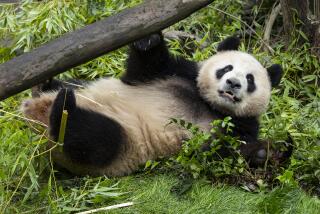No Pickles and Ice Cream for San Diego Zoo’s Panda
- Share via
SAN DIEGO — Apparently unpregnant but still charismatic, Bai Yun is back on display.
The annual panda fertility watch is over.
Attempts at artificial insemination have failed and Bai Yun, a 10-year-old giant panda, is no longer confined to her maternity area in the backstage part of the panda grotto at the San Diego Zoo.
For a month, Bai Yun had been out of public view while being watched around the clock by panda specialists for signs of pregnancy: increased irritability, a change in eating habits, annoyance at her mate, the usual things.
But late last week, zookeepers reluctantly announced that insemination with sperm from Shi Shi, the zoo’s male panda, had apparently failed.
“Increased interest in food, lowered hormone levels and diminished nesting behaviors in recent days all point to a likelihood that we’ll not see a cub this year,” said Don Lindburg, the zoo’s giant panda team leader.
Since arriving in 1996 on loan from the Chinese government, Bai Yun and Shi Shi’s reproductive drama has been played out amid the glare of media attention.
“Everybody has been rooting for them,” said Barbara Street, a zoo regular and a secretary at a San Diego law firm.
This is a city that loves its zoo animals: It celebrates their arrivals, holds parties on their birthdays and mourns their passing. And none so much as the pandas, known among zoo specialists as “charismatic megavertebrates” in testimony to their almost hypnotic appeal.
Among the difficulties of panda reproduction is that the female is in season only two days a year. Males and females often would rather fight than mate. In captivity, males sometimes lose all desire or do not seem to know the rudiments of rutting.
Wild-born and more than 20 years old, Shi Shi has shown no interest in the natural system of sperm delivery, somewhat to Bai Yun’s frustration.
“Shi Shi has been a disappointment,” said Bill Sullivan, an accountant and regular panda watcher.
In 1997, zookeepers and Bai Yun waited for Shi Shi to do the right thing. He didn’t. In 1998, attempts were made at artificial insemination. That didn’t work.
In 1999, however, bingo: Bai Yun became pregnant, albeit artificially.
To the delight of panda lovers worldwide, Bai Yun gave birth to Hua Mei two years ago. (There was a party at the zoo Tuesday, complete with a bamboo birthday cake and extensive television coverage.)
The birth was doubly joyous given the repeated and high-profile failures of another panda pair at the National Zoo in Washington.
Panda specialists had hoped the arrival and survival of Hua Mei showed that scientists were close to unlocking the reproductive secrets of pandas, one of the world’s most endangered species.
This year’s failure suggests such optimism was premature.
Shi Shi is set to be replaced as a sperm donor. San Diego Zoo officials are eyeing a 12-year-old captive male in China. A team is preparing to go to China in September to evaluate his suitability.
“This is a time for renewed effort,” Lindburg said.
More to Read
Sign up for Essential California
The most important California stories and recommendations in your inbox every morning.
You may occasionally receive promotional content from the Los Angeles Times.













